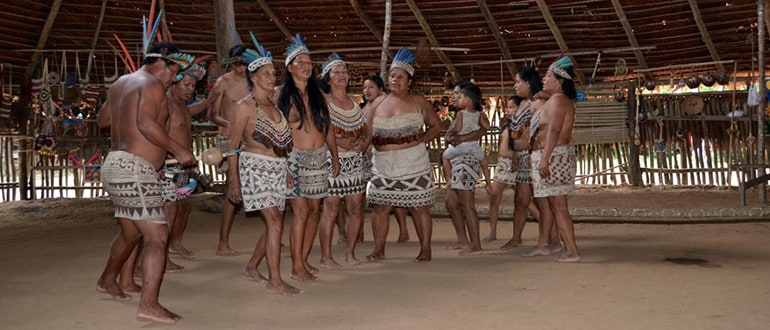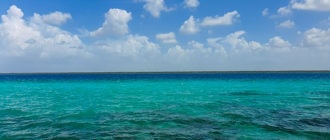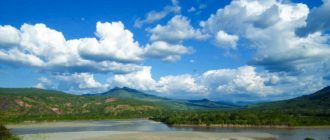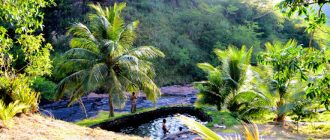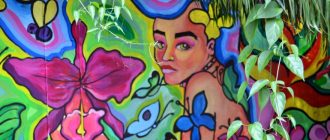Brief information about some indigenous tribes living in the territory of Peru. Population, their location, and economic activity.
Machiguenga or Matsigenka
Population: 8,679 people (1993 census).
Location: They live in the provinces of Cusco, Madre de Dios, Ayacucho, along the Urubamba River and its tributaries Picha, Comisea, Timpia, and Manu.
Economic Activity: Agriculture, hunting, and fishing. Currently, the Machiguengas grow cocoa, coffee, and achiote for sale. Under the influence of Dominican missionaries, cattle farming has been introduced. Sometimes, the Machiguengas are hired for logging. They also work temporarily for oil companies and develop their traditional crafts.
Boras
Population: 371 people (1993 census).
Location: They live in the Amazon region along the Ampiyacu, Putumayo, and Yaguasuacu Rivers.
Economic Activity: Agriculture (they grow bitter cassava, from which they make cassava bread, their staple food), hunting, fishing, and gathering. They grow bananas and rice for sale. Recently, they have established connections with tour companies. For visiting tourists, they organize folklore dance performances. They develop their traditional crafts.
Awajun or Aguarunas
Population: 45,137 people (1993 census).
Location: They live in the provinces of Amazonas, San Martin, Loreto, and Cajamarca.
Economic Activity: Agriculture, hunting, and fishing. They grow bananas and rice for sale. Besides rice production, they send cocoa and bananas to the Chiclayo market using a primitive road that reaches their territory. They develop their traditional crafts.
Iné
Population: Approximately 5,000 people.
Location: They live in the provinces of Cusco and Ucayali.
Economic Activity: Agriculture, hunting, and fishing. Textile craftsmanship is an important source of income.
Jivaro
Population: 52 people counted in the 1993 census, but currently around 2,000 inhabitants.
Location: They live in the province of Loreto along the Tigre, Corrientes, and Macusari Rivers.
Economic Activity: Agriculture, hunting, fishing. They raise poultry and livestock. The main crops are cassava, bananas, corn, cotton, and tobacco. They develop their traditional crafts. Some Jivaros work for oil companies extracting oil in their territory.
Huitoto
Population: 1,917 people (1993 census).
Location: They live in the province of Loreto along the Ampiyacu, Putumayo, Napo, Nanay, and Yaguasuacu Rivers.
Economic Activity: Agriculture—growing bananas, corn, peanuts, sweet potatoes, and sapayo. Their diet is supplemented by hunting, gathering, and fishing. Recently, the Huitotos have established connections with tour companies. For visiting tourists, they organize folklore dance performances. They develop their traditional crafts.
Yanesha or Amuesha
Population: 6,980 people (1993 census).
Location: They live in the provinces of Huanuco, Junin, and Pasco along the Palcazu, Pichis, Pachitea, Huancabamba, Cacazu, Chorobamba, and Yurinaqui Rivers.
Economic Activity: Agriculture is their primary economic activity. The main crops include cassava, bananas, pituca, sachapapa, sweet potatoes, corn, rice, and various fruits. Commercial agriculture has developed significantly in this group, especially in villages in the Oxapampa and Villa Rica areas, focused on coffee and achiote cultivation. They develop their traditional crafts.
Quechua
Population: 2,175 people (1993 census).
Location: They live in the province of Loreto along the Tigre, Pastaza, Maranon, Huallaga, and Corrientes Rivers. In Ecuador, they are known as Canelos Quechuas.
Economic Activity: Agriculture, hunting, and fishing. The main crops grown in their gardens are cassava, bananas, corn, rice, and cotton. Many Quechuas work in timber harvesting. They develop their traditional crafts.
Shipibo-Conibo
Population: 20,178 people (1993 census). Currently, there are around 40,000 inhabitants.
Location: They live along the Ucayali River and its tributaries.
Economic Activity: Agriculture (bananas, papaya, cassava, and corn), fishing is very important for both their diet and trade. Many Shipibos work in logging. Traditional crafts and the sale of handicrafts make up a significant part of their income.
Ese Eja
Population: 600 people (1993 census), currently around 1,900 inhabitants.
Location: They live in the Madre de Dios region along the Madre de Dios, Tambopata, and Yat Rivers. They also live in Bolivia, where they are known by the same name.
Economic Activity: Agriculture, hunting, and fishing. They sell small surpluses of corn, rice, cassava, and bananas at the market. They develop their traditional crafts.
Nomatsigenga
Population: 5,531 people (1993 census).
Location: They live in the province of Junin along the Alto Pangoa, Sanibeni, Anapati, and Kiatari Rivers.
Economic Activity: Agriculture—growing cassava, bananas, pituca, sachapapa, sweet potatoes, peanuts, corn, rice, and various fruits. They engage in hunting and fishing. They develop their traditional crafts.
Kokama-Kokamilla
Population: 10,705 people (1993 census).
Location: They live in the provinces of Loreto and Ucayali along the Ucayali, Huallaga, Napo, and Amazon Rivers.
Economic Activity: The Kokama people are highly integrated into the regional Amazonian economy, combining subsistence and commercial agriculture with various forms of wage labor. They develop their traditional crafts.

